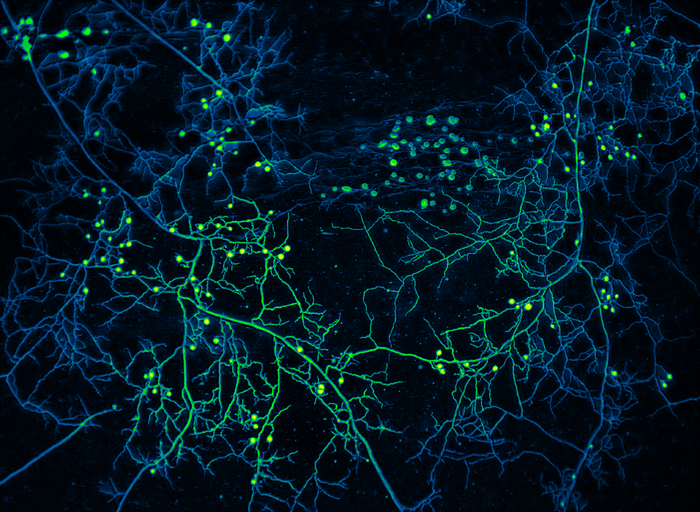Mycorrhizal fungi have indeed been supporting terrestrial life for at least 450 million years by providing plants with soil nutrients necessary for growth. Scientists have discovered that, in addition to creating symbiotic connections with nearly all land plants, these fungi are key carbon transporters into soil ecosystems.
 Mycelium of arbuscular mycorrhizal fungi with false color. Image Credit: Oyarte-Galvez (AMOLF)
Mycelium of arbuscular mycorrhizal fungi with false color. Image Credit: Oyarte-Galvez (AMOLF)
According to a meta-analysis published on June 5th, 2023, in the journal Current Biology, mycorrhizal fungi receive up to 13.12 gigatons of carbon dioxide equivalents (CO2e) fixed by terrestrial plants each year, which is roughly comparable to 36% of annual worldwide fossil fuel emissions.
Since 70–90% of land plants create symbiotic associations with mycorrhizal fungi, researchers have long assumed that a considerable quantity of carbon must be flowing into the soil via their networks.
We always suspected that we may have been overlooking a major carbon pool. Understandably, much focus has been placed on protecting and restoring forests as a natural way to mitigate climate change. But little attention has been paid to the fate of the vast amounts of carbon dioxide that are moved from the atmosphere during photosynthesis by those plants and sent belowground to mycorrhizal fungi.”
Heidi Hawkins, Research Lead, Conservation South Africa
Heidi Hawkins is also a research associate on plant-soil-microbe interactions at the University of Cape Town.
Mycorrhizal fungi exchange mineral nutrients for carbon with their plant partners. Associations between fungal mycelium, the thread-like filamentous networks that make up the majority of fungal biomass, and plant roots allow for these bidirectional exchanges.
Carbon is used by mycorrhizal fungi to build a more extended mycelium, which allows them to explore the soil. It is also bound up in soil by the fungi’s sticky chemicals and can persist underground in the form of fungal necromass, which serves as a structural scaffold for soils.
Scientists have determined that carbon flows through fungi, but they do not even know how long it stays there.
A major gap in our knowledge is the permanence of carbon within mycorrhizal structures. We do know that it is a flux, with some being retained in mycorrhizal structures while the fungus lives, and even after it dies. Some will be decomposed into small carbon molecules and from there either bind to particles in the soil or even be reused by plants. And certainly, some carbon will be lost as carbon dioxide gas during respiration by other microbes or the fungus itself.”
Heidi Hawkins, Research Lead, Conservation South Africa
The study is part of a global effort to better understand the role of fungi in Earth's ecosystems.
We know that mycorrhizal fungi are vitally important ecosystem engineers, but they are invisible. Mycorrhizal fungi lie at the base of the food webs that support much of life on Earth, but we are just starting to understand how they actually work. There’s still so much to learn.”
Toby Kiers, Study Senior Author and Professor, Evolutionary Biology, Vrije University
Toby Kiers is the co-founder of the Society for the Protection of Underground Networks (SPUN).
And yet there is a race against time to recognize and protect these fungi. The United Nations Food and Agriculture Organization says that 90% of soils may be damaged by 2050, while fungi are mostly ignored in conservation and environmental policy. The production of both natural and crop plants will decline rapidly if soil fertility and structure are not provided.
Mycorrhizal fungi represent a blind spot in carbon modeling, conservation, and restoration. Soil ecosystems are being destroyed at an alarming rate through agriculture, development, and other industry, but the wider impacts of disruption of soil communities are poorly understood. When we disrupt the ancient life support systems in the soil, we sabotage our efforts to limit global heating and undermine the health and resilience of the ecosystems on which we depend.”
Katie Field, Study Co-Author and Professor, University of Sheffield
“Many human activities destroy underground ecosystems. Besides limiting the destruction, we need to radically increase the rate of research. Organizations like SPUN, the Fungi Foundation, and GlobalFungi are leading a massive global sampling effort to create open-source maps of Earth’s fungal networks. These maps will help chart the properties of underground ecosystems, such as carbon sequestration hotspots, and document new fungal species able to withstand drought and high temperatures,” says co-author Merlin Sheldrake.
While the scientists' estimates are based on the best available evidence, they are imperfect and should be viewed with caution, according to the researchers. “Although our numbers are only estimates, they are the best we are able to make with the data available. The limitations of our study make clear the urgent need for further empirical study of carbon and nutrient fluxes between plants and mycorrhizal fungi,” concludes Sheldrake.
Source:
Journal reference:
Hawkins, H. J., et al. (2023) Mycorrhizal mycelium as a global carbon pool. Current Biology. doi.org/10.1016/j.cub.2023.02.027.